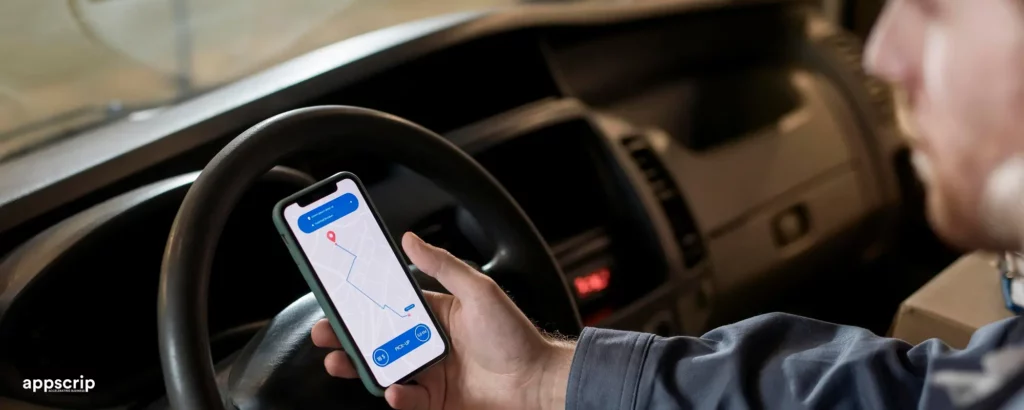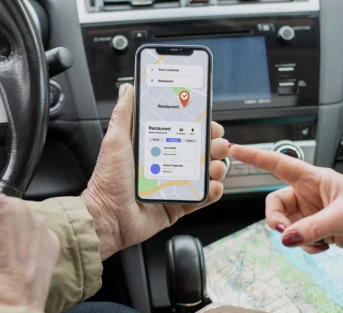Have a game-changing idea for a transportation app? The demand is huge, but turning that idea into a successful business takes more than just an app launch. The real challenge is building a platform that people trust, use, and keep coming back to.
In this guide, we will cover everything you need to launch and scale your transportation app development scene, from costs to monetization strategies. If you want to skip the long development process and get to market faster, Appscrip’s ready-made solutions can help you build with confidence. Let’s get started.
TL;DR
1. Transportation App Market Trends: The industry is evolving with ride-hailing, logistics, and corporate mobility apps dominating. AI-driven logistics and EV-friendly transport present new opportunities.
2. Must-Have Features: Essential features include real-time GPS tracking, payment integration, driver and fleet management, AI-powered route optimization, and predictive analytics for smarter operations.
3. Development Costs: Costs range from $30K for a basic MVP to $200K+ for an advanced app with AI dispatch and predictive analytics. Factors include tech stack, custom development, and post-launch expenses.
4. Monetization Strategies: Revenue models include commissions per ride, subscription plans, surge pricing, in-app ads, corporate partnerships, and white-label licensing.
5. Growth & Scaling Strategies: Scaling successfully requires strong user acquisition, referral programs, automation, AI-driven demand forecasting, and multi-city expansion planning.
6. Why Appscrip? Appscrip provides ready-made, customizable transportation app solutions that help businesses launch faster, reduce costs, and scale efficiently with cutting-edge technology.
Understanding the Transportation App Market & Key Trends
Logistics apps are making deliveries smarter, public transit apps are improving urban mobility, and corporate transportation solutions are gaining traction. The key is identifying the right niche and seizing market gaps before someone else does.
The Four Major Types of Transportation Apps
Let’s break down the biggest categories, their potential, and how startups can disrupt the space:
Ride-Hailing Apps (Uber, Lyft, Bolt)
Ride-sharing is a massive market, expected to exceed $200 billion by 2030 as cities grow and personal car ownership declines. But one of the biggest gaps in this space is EV-friendly ride-sharing. With governments pushing for sustainability, countries like the UK and Germany are planning to phase out gas-powered vehicles by 2035, making way for a new wave of electric-only ride-hailing platforms. A startup that leads this shift can establish itself as the go-to eco-friendly alternative.
Freight & Logistics Apps (Uber Freight, Convoy)
The logistics sector is undergoing rapid digital transformation, with $25 billion projected in logistics tech investment by 2025. AI-driven logistics is a growing opportunity, as companies that use AI for route optimization and demand prediction are reducing operational costs by up to 15%. The market still lacks solutions that provide real-time visibility and automation for small to mid-sized logistics businesses.
Public Transport Apps (Moovit, Transit App)
Smart cities are driving demand for better public transit solutions, with over 60% of global commuters relying on apps to plan their trips. However, most existing platforms focus on large-scale urban transit, leaving a gap for hyperlocal transport solutions such as campus-specific transit, neighborhood ride-sharing, and on-demand shuttle services. Startups that fill this need can dominate high-density, underserved areas.
Corporate Mobility Solutions (Kapten, FreeNow)
The shift to flexible and sustainable employee transport is growing fast, with companies investing in B2B transport solutions to offer on-demand shuttles, car-sharing, and corporate ride-hailing. There is a significant gap in custom transportation solutions for business hubs, factories, and office parks, where companies need tailored, cost-effective mobility options.
While, some businesses are also exploring employee rewards software to motivate staff who choose eco-friendly or shared travel options, tying recognition directly to sustainable commuting habits.
Up next, let’s talk about the must-have features your app needs to compete and win.
Must-Have Features for Your Transportation App
Whether you are launching a ride-hailing app, a freight management platform, or a public transport solution, the right features can make or break your success.
Customer App (Client App for Logistics)
This is the face of your transportation business. It should be simple, intuitive, and offer a seamless booking and tracking experience.
- Real-Time GPS Tracking: Allows users to track their ride, delivery, or shipment in real time.
- Seamless Payment Options: Support for credit/debit cards, digital wallets, BNPL (Buy Now, Pay Later), and even cryptocurrency.
- Booking & Scheduling: Instant booking, pre-scheduling, and recurring ride or delivery options.
- Ride/Delivery Fare Estimates: Transparent pricing before confirming a booking.
- Rating & Review System: Enables users to rate drivers and service providers for quality assurance.
- Multi-Modal Transport Integration: Allows users to switch between ride-hailing, bike rentals, and public transit in a single app.
- Voice & Chat Support: AI chatbot or live customer support to address concerns instantly.
- Eco-Friendly Options: Option to select electric or hybrid vehicles for sustainability-conscious users.
Driver App
The driver app should be optimized for efficiency, ensuring smooth navigation, better earnings, and safety.
- Trip & Delivery Requests: Drivers can accept or decline ride and delivery requests based on availability.
- Navigation & Route Optimization: AI-driven recommendations for the fastest and most cost-efficient routes.
- Earnings & Payout Management: A dashboard to track daily/weekly earnings and request payouts.
- Ride History & Performance Analytics: A feature to track completed rides, customer feedback, and overall ratings.
- SOS & Safety Features: Emergency contact, panic button, and ride-sharing verification for driver security.
- Heat Maps & Demand Forecasting: Helps drivers find high-demand areas for better ride availability and earnings.
- Multiple Ride & Delivery Modes: Allows drivers to switch between passenger transport, food delivery, or package transportation.
Admin App
The admin panel is the control center for managing operations, tracking drivers, and analyzing business performance.
- Fleet Management Dashboard: Enables real-time tracking of vehicles, drivers, and ongoing rides or deliveries.
- User & Driver Management: A centralized hub to approve, deactivate, or monitor customers and drivers.
- Pricing & Surge Control: Dynamic pricing adjustments based on demand, time, and location.
- Analytics & Reporting: Insights on bookings, earnings, customer behavior, and operational efficiency.
- Customer Support & Dispute Resolution: Tools to handle user complaints, refunds, and conflict resolution.
- Promo Codes & Referral Management: Ability to create and track discount offers and referral programs.
- Regulatory Compliance & Safety Monitoring: Ensures adherence to transport laws and enables proactive monitoring of driver behavior.
The best strategy is to start lean with an MVP (Minimum Viable Product). Focus on core features, gather real user feedback, and refine your app based on actual market demand.
To get there faster and more cost-effectively, partnering with an experienced development team can make all the difference. Appscrip offers pre-built, customizable transportation app solutions that help businesses launch quickly without compromising quality.

Choosing the Right Tech Stack for Your Transportation App
Selecting the right technology stack is one of the most critical decisions in transportation app development. Your choice will impact performance, scalability, security, and development speed. The right stack ensures that your app can handle high traffic, process payments securely, and provide real-time tracking without lag.
Backend Technologies
The backend is the engine that powers your app, managing requests, processing data, and ensuring smooth communication between users, drivers, and administrators.
- Node.js – A fast, scalable option for handling high-traffic applications.
- Python (Django, Flask) – Ideal for AI-driven logistics apps with predictive analytics.
- Ruby on Rails – Great for startups that want rapid development with clean code.
- Firebase (Google Cloud) – A backend-as-a-service option for quicker deployments.
Frontend Technologies
Your frontend must be fast, intuitive, and responsive across devices.
- React Native – A popular choice for cross-platform apps, reducing development costs.
- Flutter – Google’s UI toolkit, great for smooth animations and a native feel.
- Swift (iOS) & Kotlin (Android) – Best for performance-heavy native applications.
APIs & Third-Party Integrations
A transportation app relies on various APIs to enhance user experience and functionality.
- Google Maps API / Mapbox – For real-time tracking and route optimization.
- Stripe / PayPal / Razorpay – Secure payment gateway integrations.
- Twilio / Firebase Cloud Messaging – SMS and push notifications for seamless communication.
- Auth0 / Firebase Authentication – Secure login and user verification.
Database Management
A robust database ensures that user, driver, and admin data is stored securely and retrieved quickly.
- PostgreSQL – Best for handling structured data and scalable queries.
- MongoDB – Ideal for apps requiring flexible and fast data retrieval.
- Redis – Used for caching to improve app speed and efficiency.
Cloud Services & Hosting
Reliable cloud hosting is essential for uptime, security, and performance.
- AWS (Amazon Web Services) – Industry leader for scalable cloud infrastructure.
- Google Cloud Platform (GCP) – Strong AI and machine learning capabilities.
- Microsoft Azure – Preferred by enterprises needing security and compliance.
Choosing the right combination of backend, frontend, and integrations ensures that your app is secure, high-performing, and future-ready.
Development Timeline & Roadmap for Your Transportation App
A clear timeline helps you stay on track, prioritize features, and get your transportation app to market faster without unnecessary headaches. Here is how to break down your development process for a smooth and successful launch.
Phase 1: Research & Planning (1 to 2 Months)
Before writing a single line of code, you need a solid plan. Think of this as laying the foundation for a skyscraper. You would not start building without blueprints, right?
- Market Research & Competitor Analysis: Figure out what is working, what is not, and where your app can stand out.
- Business Model Validation: Define how your app will make money and keep users engaged.
- Legal & Compliance Review: Avoid regulatory headaches by ensuring your app meets local transport laws.
- Choosing the Right Tech Stack: Pick the right backend, frontend, and APIs for performance and scalability.
Phase 2: UI/UX Design & Prototyping (1 to 2 Months)
A transportation app has to be fast, intuitive, and easy to use. Nobody wants to struggle with a clunky interface when they need a ride.
- Wireframing & Prototyping: Lay out your app’s flow, from booking a ride to completing a payment.
- User Testing & Feedback: Gather early feedback to fine-tune the user experience.
- Finalizing the Design: Make sure everything feels smooth and natural before development starts.
Phase 3: App Development & Testing (3 to 6 Months)
This is where the magic happens, turning your idea into a working app.
- Backend Development: Set up ride dispatching, payment processing, authentication, and database management.
- Frontend Development: Build user-friendly interfaces for passengers, drivers, and admins.
- Integrating APIs: Connect payment gateways, real-time GPS tracking, and push notifications.
- Testing & Bug Fixes: Fix glitches, optimize speed, and ensure everything runs without hiccups.
Phase 4: Beta Testing & Soft Launch (1 to 2 Months)
Launching a full-scale app without testing is like driving blindfolded. Risky and unnecessary.
- Beta Testing with Real Users: Invite a small group of riders and drivers to test the app in real-world conditions.
- Performance Monitoring: Identify bugs, optimize features, and ensure a seamless experience.
- Pre-Launch Marketing & Promotions: Create buzz through social media, referral programs, and strategic partnerships.
Phase 5: Full-Scale Launch & Growth (Ongoing)
- Official Launch & Onboarding: Ensure a smooth rollout with an easy sign-up process.
- Continuous Updates & Feature Enhancements: Improve based on real user feedback.
- Growth & Expansion Plans: Scale to new cities, optimize operations, and keep your app competitive.
Without a plan, it is easy to lose time, burn through your budget, or miss key features that users expect. But do you want to get your app on the market, without the usual delays? We will discuss how it works, but before that let’s look at the costs involved.
How Much Does It Cost to Build a Transportation App?
The cost of transportation app development depends on factors like features, complexity, technology stack, and development team location. Here is a detailed look at what influences app development costs and how you can optimize your budget.
Cost Breakdown by Complexity
| Complexity Level | Estimated Cost | Features |
| Basic MVP | $30K–$50K | Essential booking system GPS tracking Basic payment options Simple UI/UX Minimal admin panel |
| Mid-Tier App | $80K–$150K | Multi-modal transport support AI-powered route optimization Enhanced security features Custom branding Scalable backend infrastructure |
| Advanced App | $200K+ | Predictive analytics Automated fleet management AI-driven dispatch system Enterprise-level security Full customization capabilities |
What Impacts the Cost?
- Where Your Development Team is Based: Hiring developers in North America or Western Europe is significantly more expensive than working with teams in Eastern Europe or Asia.
- Custom vs. White-Label Solutions: A fully custom app gives you total control but takes longer and costs more. A white-label solution, like what Appscrip offers, helps reduce development time and expenses.
- Backend Infrastructure Costs: Cloud services, databases, and server management all add to long-term operational costs.
- Post-Launch Expenses: Budgeting for app maintenance, updates, server hosting, and customer support is just as important as the initial build.
How to Keep Costs Down Without Compromising Quality
- Start Small, Scale Smart: Launch with a Minimum Viable Product (MVP) that includes only the must-have features. Test the market and add features as you grow.
- Choose the Right Development Partner: Outsourcing to a skilled team can cut costs while maintaining quality.
- Leverage Open-Source Tools: Proven frameworks and third-party APIs can save time and money instead of building everything from scratch.
A well-planned budget ensures that your transportation app remains competitive without unnecessary financial strain. Whether you need a ride-hailing platform, a logistics app, or a fleet management system, Appscrip’s pre-built frameworks can save both time and money.
But that’s not all, we will now look at the monetization strategies to help recover the development budget and make your app profitable.
Monetization Strategies: How to Make Money with a Transportation App
Commission-Based Model
Most ride-hailing and delivery apps charge a commission on each transaction, making it one of the most common revenue models. Apps like Uber and Lyft typically charge 15% to 30% per ride, while food delivery and freight services follow the same approach.
- Works best for apps that connect users with drivers, couriers, or service providers.
- Revenue grows as more transactions happen on the platform.
- Provides a scalable income stream, ensuring profitability as demand increases.
Subscription & Membership Plans
Some users and businesses prefer a predictable cost rather than paying per ride or delivery. Subscription plans offer premium benefits for a fixed monthly fee.
- Uber One provides reduced fares and free deliveries through a paid membership.
- Logistics apps charge businesses for premium tracking, analytics, and fleet management tools.
- This model increases customer retention while ensuring steady revenue.
Surge Pricing & Dynamic Fare Adjustments
Transportation demand fluctuates throughout the day, and surge pricing ensures profitability even in high-demand situations.
- Fares automatically increase during peak hours, bad weather, or major events.
- Encourages more drivers to be available when demand is high.
- Freight services adjust shipping rates in real-time to maximize revenue during busy periods.
In-App Advertising & Sponsored Listings
If your app attracts a large number of daily users, businesses will pay to advertise their services.
- Fuel stations, insurance companies, and local businesses can run ads inside your app.
- Drivers or fleet operators can pay for premium visibility in search results.
- Works best for ride-hailing, public transit, and logistics apps with a large user base.
Corporate Partnerships & B2B Solutions
Many companies need transportation solutions for employees, deliveries, or logistics. Partnering with businesses offers steady income and long-term contracts.
- Offer exclusive ride-hailing, shuttle services, or last-mile delivery for companies.
- Charge per employee usage or offer fixed monthly pricing.
- Best suited for corporate mobility, B2B logistics, and specialized transport services.
Affiliate & Referral Programs
Forming partnerships with complementary businesses helps generate additional revenue while adding value for users.
- Ride-hailing apps can partner with insurance companies, earning commissions for driver policy sign-ups.
- Logistics platforms can collaborate with fuel stations, offering driver discounts while sharing revenue with the platform.
- These partnerships enhance user engagement and create new revenue streams.
There is no single best strategy for successful monetization, the most successful transportation apps combine multiple revenue streams to maximize profitability and scale efficiently.
Why Appscrip is the Right Partner for Your Transportation App
Bringing a transportation app to life is no small feat. It takes time, money, and a solid tech foundation to make it work. But what if you could skip the months of development steps mentioned above, cut costs, and launch faster with a proven platform? That’s exactly why Appscrip offers ready-made, customizable solutions built for speed, scalability, and success.
Launch Fast with a Pre-Built Solution
- No need to build from scratch. Appscrip’s pre-built solutions let you hit the market in weeks, not months.
- Whether it’s ride-hailing, logistics, corporate mobility, or multimodal transport, we customize it to fit your business.
- Designed for growth and scalability, so your app keeps up as demand rises.
Save Time, Cut Costs, and Avoid Development Pitfalls
- Building from scratch can take 12+ months and cost six figures. With Appscrip, you launch in weeks at a fraction of the cost.
- Forget hiring an in-house dev team, because we have already done the heavy lifting.
- Our continuous updates and tech improvements keep your app competitive with zero extra effort on your end.
Trusted by Transportation Businesses Worldwide
- Appscrip powers different ride-hailing, logistics, and mobility platforms globally.
- Built by industry experts who understand the unique challenges of the transportation sector.
Your Shortcut to Success
With Appscrip, you bypass the usual roadblocks and launch faster with a platform that works from day one. Whether you’re starting a ride-hailing service, logistics company, or corporate transport solution, we make it simple, scalable, and cost-effective.
Why waste time building from scratch? Let’s get your transportation app live. Talk to Appscrip today and launch your business the smart way.
FAQs
How do I choose the right features for my transportation app MVP?
When building an MVP, focus on features that solve your users’ biggest pain points. Essential features include real-time GPS tracking, booking and dispatching, payment integration, and customer support. Avoid adding too many advanced features in the initial phase, start simple, gather user feedback, and expand strategically.
What are the biggest challenges in launching a transportation app, and how can I overcome them?
Some of the most common challenges include driver and user acquisition, regulatory compliance, app scalability, and ensuring a seamless user experience. Overcome these by launching with a well-thought-out marketing strategy, partnering with local businesses, ensuring compliance with transport laws, and using a scalable tech stack that supports future growth.
How can I ensure my transportation app remains competitive in the long run?
Staying competitive requires continuous updates, leveraging AI for smarter operations, improving user experience based on feedback, and expanding into underserved markets. Offering features like dynamic pricing, AI-powered route optimization, and multi-modal transport options can also give your app a long-term advantage.
How much should I budget for post-launch maintenance and updates?
After launch, ongoing costs typically range from 15% to 25% of initial development costs per year. This includes bug fixes, security updates, server costs, customer support, and feature improvements. Having a post-launch strategy ensures your app remains reliable, scalable, and user-friendly.





